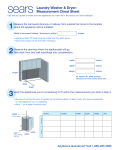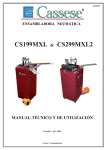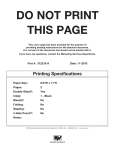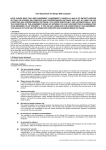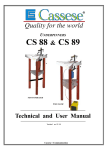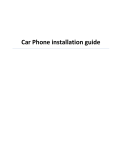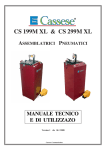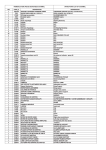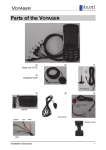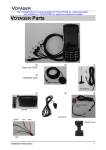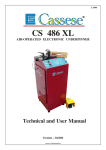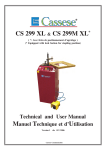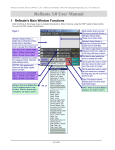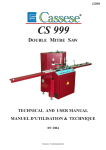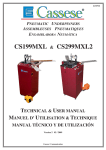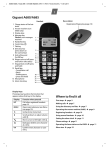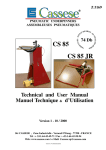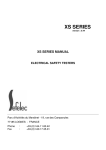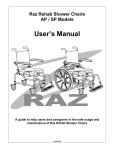Download Manual - Cassese
Transcript
Z21514 PNEUMATIC UNDERPINNERS CS199MXL & CS299MXL2 TECHNICAL & USER MANUAL Version 3 05 / 2011 Cassese / Communication WORK Fig N° 1 POSITION ANGLE ADJUSTMENT Pr CA H SCREW AS LEFT BACKFENCE B2 RIGHT BACKFENCE STAPLING BUTTON B1 SB LOCK BUTTON FOR MB STAPLING POSITION AS PG VA SB M CA WIRE FOR WEDGE PUSHING SPRING F CLAMPS G1 G2 WEDGE DISTRIBUTOR H SLIDING TABLE CS199MXL BLOCKING LEVER MB BLOCKING LEVER FOR Fig N° 2 STAPLING BLOCKING LEVER FOR 2nd STAPLING POSITION Po G2 MB B2 G1 POSITION P2 CLAMP POSITION TC B1 BUTTON F PG TOP PRESSER BRACKET Po QUICK-CHANGE MAGNETIC TOP CLAMPS Pr ANGLE ADJUSTMENT SLIDING TABLE CA P2 P1 RI TC CS 199MXL & CS299MXL2 PNEUMATIC FRAME ASSEMBLING MACHINES P1 CS199MXL Fig N° 3 CS299MXL2 RId REMOVABLE CLAMPS RIg BACKFENCES BR GE CS299MXL2 GE BR LEFT ADJUSTMENT BUTTON FOR THE INCLINATION OF THE FENCES RIg RIGHT ADJUSTMENT BUTTON FOR THE INCLINATION OF THE FENCES RId BUTTON TO ADJUST THE PRESSURE OF THE HORIZONTAL CLAMPS. Minimum allowed pressure is 2 bars. To be used when you replace regular clamps with soft rubber clamps or when you join very softwood moulding. A ACCESSORIES ACCESSORIES SUPPLIED WITH THE MACHINE CS199MXL QTY Z 21 51 0 Z 1 338 Z 1 783 Z 1 791 Z 1 8065 Z 1 879 Z 1 884 Z 1 885 Z 1 896 Z 1 993 Z 21 500 Z 3078 Z 4857 Z506 Z 535 Z 556 Z 5897 Z 6532 Z 701 Z 749 Code 1 4 1 1 1 1 1 1 1 1 1 1 4 1 1 1 1 1 1 1 Désignation ACCESSORIES SUPPLIED WITH THE MACHINE CS299MXL QTY S/ E ACCESSOR Y BOX CS1 99MXL NU T HM 1 2 YELLOW R UBBER 30 MM 70 SHOR ESES GR EEN R UBBER 30 MM 90 SHOR ESES R UBBER SUPPOR T ALLEN KEY 2.5 ALLEN KEY 4 ALLEN KEY 5 T UBE OF GR EASE CAR T ON 240 X 1 70 X 50 ADJUSTABLE BUNG AXIS SPACER BARS D FOOT : 40 M1 2 X 50 SHOR T HAMMER T OOL STANDARD HOSE CONNECTOR M1/4 CYL PLAST I C SACHET GR I P 8 X 1 2 BALL LOCK D: 8 X 40 USAGESES MALE FER R ULE M 1 / 4 TEFLONE QUICK RELEASE FEMALE CONNECTOR 1 / 4 Z 21 51 1 Z 1 338 Z 1 783 Z 1 791 Z 1 800 Z 1 804 Z 1 8065 Z 1 879 Z 1 884 Z 1 885 Z 1 896 Z1993 Z21500 Z3078 Z 4857 Z506 Z 535 Z 556 Z 5897 Z 6532 Z 701 Z 749 Code Désignation 1 4 1 1 1 1 S/ E ACCESSOR Y BOX CS299MXLP NU T HM 1 2 YELLOW R UBBER 30 MM 70 SHOR ESES GR EEN R UBBER 30 MM 90 SHOR ESES YELLOW R UBBER 45 MM 70 SHOR ESES GR EEN R UBBER 45 MM 90 SHOR ESES R UBBER SUPPOR T ALLEN KEY 2.5 ALLEN KEY 4 ALLEN KEY 5 T UBE OF GR EASE CAR T ON 240 X 1 70 X 50 ADJUSTABLE BUNG AXIS SPACER BARS D FOOT : 40 M1 2 X 50 SHOR T HAMMER T OOL STANDADR HOSE CONNECTOR M1/4 CYL PLAST I C SACHET GR I P 8 X 1 2 BALL LOCK D: 8 X 40 QUICK RELEASE US M 1/4 TEFLONE QUICK RELEASE FEMALE CONNECTOR 1 / 4 1 1 1 1 1 1 1 1 4 1 1 1 1 1 1 1 AIR LINE FITTINGS Advised way of fitting : USA Z675 STANDARD Male Connector on Machine Z675 quick release (Q/R) female air connector Z749 Z749 Q/R US male connector Standard hose connector Z556 Z701 AIR SOURCE B CS199MXL & CS299MXL2 - USER’S TECHNICAL MANUAL CONTENTS Page INTRODUCTION DESCRIPTIVE ACCESSORIES SUPPLIED WITH THE MACHINE TECHNICAL SPECIFICATIONS OPTIONS GUARANTEE A B 2 2 2 PUTTING INTO OPERATION - Reassembly - Connecting the machine to air supply 3 3 ADJUSTMENTS - Adjustment of the sliding table - Selection of stapling positions - Setting and storing the stapling position - Selection of top presser end - Using the set of spacer bars - Adjustment of the inclination of fences - Adjustment of the assembly angle 4 4 5 6 6 6 7 USE - Means of assembly - Loading and changing the wedge cartridge on machine - Joining the frame 8 8 8 MAINTENANCE LUBRICATION CLEARING OF A WEDGE STUCK IN THE WEDGE DISTRIBUTOR IN CASE OF HAMMER AND WEDGE JAMMING DISMOUNTING THE SLIDING TABLE GENERAL ADVICE TROUBLE SHOOTING CHART Cassese Communication - 06 / 2008 9 9 10 11 11 12, 13 INTRODUCTION You have just bought a Cassese Pneumatic Joining Machine, so we congratulate on your sensible choice and thank you for your trust in Cassese products. These machines benefits from the experience of the joining machines that brought Cassese a certain reputation. It makes it possible to join wooden mouldings of all profiles ( patent n° 7522814). The CS underpinners are designed to allow the operator to move all around the machine. The joining operation is carried out by using metal wedges especially designed to perform a tight join. These wedges come in throw-away plastic cartridges, without glue, individually lubricated and rust-protected for the toughest challenges. IMPORTANT : You should not use other wedge cartridges than those developed by Cassese ( registered mark CS) TECHNICAL SPECIFICATIONS OF CS199MXL & CS299MXL2 - Minimum moulding width : 5mm (3/16”) - maximum width : 130 mm (5¼”) Minimum moulding height : 7 mm (¼”)- maximum height : 90 mm (3¾”) Minimum dimensions of a frame : 85 mm x 85 mm visibly (3½” x 3½”). Wedge sizes in cartridges of 275 pieces : 3, 5, 7, 10, 12 and 15 mm. Two wedge types : for soft and for hardwoods. Machine weight : 70 kg (155 lbs) Dimensions : W 450 mm x L 490 mm (without optional rotating table)x H 1100 mm Height of work table : from 900 to 930 mm ( following adjustment of the feet ) Pneumatic supply : compressed air 7 bar (100 psi), Average consumption : 5 litres per cycle. Air conditioning : air pressure reducing valve + manometer, connecting pipe, inside diameter 8 mm. OPTIONS . Independent rotating table, diameter 1300 mm (50¼”) to make the handling of large frames easier (frame dimensions not exceeding table diameter). Set of furniture clamps to join mouldings without rebate and/or small frames. Angle inserts for 6-sided frames or 8-sided frames or other forms on request GUARANTEE One year guarantee for parts and labour against manufacturing defects. Wear parts and those damaged as a result of non appliance with the instructions of the present manual are excluded from the guarantee. 2 PUTTING INTO OPERATION REASSEMBLY Cut and remove the two ties on the case. Remove the ringfrom case. Clear the body of case while pulling it E1 upwards. With a flat key of 19 mm, remove the two nuts (E1, E2) under the pallet. E2 L MANOMETER Vg Vdr Remove the screws (Vdr,Vg) from the removable front cover of the machine. with a key allen of 4 mm. Make topple the hood. Cut the L ring. While pushing on the arm of pressor, remove the wood piece CB . Loosen the arm of plunger mildly. CB Reassemble the four feet of the machine supplied among accessories. Raise the machine from the pallet (watching out for the pedal) and put it down on the floor. Adjust the level of the machine to your floor so that the machine vibrates or moves as little as possible (which is one of the main cause of early wearing of the mechanical parts) CONNECTING THE MACHINE TO AIR SUPPLY 1) Inside the machine (see below), connect the compressed air inlet pipe by using the quick release female connection supplied with the machine ( see page B ). 2) Tie up the air bleeding pipe to the compressed air pipe, passing through the opening located on the side of the base cabinet, so that the air bleeding can be made outside the machine 2) Plug the air compressor and position the air valve (right side of the machine) to ON . Make sure pressure in manometer is equal to 6 bars (85 psi). Air bleeding pipe AIR VALVE Connection for quick release coupling + air supply REMOVABLE FRONT COVER 3 ADJUSTMENTS ADJUSTMENT OF THE SLIDING TABLE (Fig.1, TC) 1) Turn to ON the clamp position button PG ( fig1, pA) to make the clamps (G1 and G2) move forward. 2) Make sure the two inclination adjustment knobs RI of the backfences (fig 1 pA) are at zero. 3) Position a moulding against left hand fence B1 (for mouldings with a height smaller than the fence, use the spacer bars supplied with the fittings by slipping them between the fences and the small mouldings. 4) Move sliding table TC ( fig2 pA) forward as far as the clamp G1 ( fig1 pA) comes into contact with the moulding. 5) Tighten the sliding table blocking handle MB (fig1pA). 6) Turn to OFF the clamp position button PG ( fig1, pA) SELECTION OF STAPLING POSITIONS The CS 199MXL & CS299MXL2 are designed to join mouldings in one or two places (positions) without limitation of the number of wedges in any of those places. The selection depends on the width and thickness of the moulding to join. If needed, additional positions can be inserted between these two positions using the “LOCK BUTTON FOR STAPLING POSITION” (Fig 1 p A). 2 mm MINIMUM 2 mm MINIMUM 10mm 10mm 12 mm 10mm As a general rule a MINIMUM 2 mm clearance (less than 1/8”) above the wedges shall be respected. Same sized wedges can be stacked in order to avoid to have to change the cartridge size when joining frames with different thickness. AS A GENERAL RULE, THE JOINING MUST BE CARRIED OUT AS CLOSE TO THE THICKEST MOULDING PART(S) AS POSSIBLE . 4 SETTING AND STORING THE STAPLING POSITIONS Unlock the stapling position lock handles P1, P2 ( fig2 pA). For the stapling position close to the outside of the frame : Press the button CA to unlock and slide the top presser bracket Po (fig2 pA) with your right hand as far as the stapling position selected has been reached. The wedge distributor H (fig1 pA) moves at the same time underneath of the moulding and its wedge exit slot shows you exactly the position reached. Holding the bracket in position with your right hand, slide with your left hand the handle P1 forward in stop position and tighten it. For the stapling position close to the inside of the frame : Press the button CA again and slide the top presser bracket Po forward until it reaches the position chosen for the insertion of the wedge(s) inner frame side. Release now the button CA to lock the position and slide the handle P2 (fig3, p A) towards yourself until it reaches the stapling position chosen and tighten it. 1 SELECTION OF A TOP PRESSER END 1 top presser comes now with your machine as a standard feature. It fits the plunger head thanks to the pin G and can be set up in 1 to 7 positions from the table. Pay attention to position well the triangle : the sides of the triangle must be parallel to stops B1 and B2 (see fig1 page A) BLACK TRIANGLE PRESSER WHITE TRIANGLE PRESSER GREEN RUBBER TIPS YELLOW RUBBER TIPS HARD WOOD SOFT WOOD HARD WOOD SOFT WOOD 3 4 5 6 7 30 and 45 mm 30 and 45 mm Triangle top pressers are good for flat mouldings or for mouldings presenting a flat or horizontal area to come down on. The round rubber ends are good for complicated forms (uphill, downhill or reverse mouldings). Pin (G) 2 Presser Moulding LOCATING THE TRIANGLE / ROUND RUBBER TOP PRESSERS MAXIMUM HEIGHT FOR THE MOULDINGS Position hole # Rubber 30mm 1 2 3 4 5 6 7 13 mm 27 mm 42 mm 57 mm 71 mm 85 mm 100 mm Quick-change magnetic top clamps 5 Rubber 45mm / 13 27 42 57 71 85 mm mm mm mm mm mm Triangle 20 mm 35 mm 49 mm 63 mm 73 mm 92 mm 170 mm USING THE SET OF SPACER BARS In case you have to join small mouldings with a smaller height than the fences, you must put the spacer bars between the mouldings and the fences to create a distance. Presser Moulding INCORRECT Fences Wedge distributor CORRECT Set of spacer bars ADJUSTMENT OF THE INCLINATION OF THE FENCES SETTING SCREW FOR THE ASSEMBLY ANGLE ADJUSTMENT BUTTON FOR THE INCLINATION OF THE FENCES + 0 - RI If the corner has an opening underneath, turn the same two adjustment buttons (RI) an identical value to the PLUS (+) (fig 1 p A) until the opening disappears when mouldings are clamped. If the corner has an opening on top, turn the two adjustment buttons (RI) an identical value to the MINUS (-) (fig 1 p A) until the opening disappears when mouldings are clamped. 6 ADJUSTMENT OF THE ASSEMBLY ANGLE If several cutting machines are being used in your production or if you receive your mouldings already cut by your suppliers (chop service), the angles of the mouldings will be slightly different from one cutting machine to the other. The joining angle of your machine can be adapted to find precisely the cutting angle of your cutting machine. ANGLE ADJUSTMENT SCREW If the corner is open towards outside, screw in the adjustment screw (see photo page 6 ) for the assembly angle AS (fig 1 p A) to correct the fault and check the quality of the angle by clamping the corner again. Outside Inside If the corner is open towards inside, unscrew the angle adjustment screw AS (fig 1 p A) to correct the fault and check the quality of the corner by clamping the mouldings again. If you get this result, check your cutting angle, which is wrong in this case because it is less than 45°. Carry out the adjustment of the angle of your cutting machine. IT IS IMPOSSIBLE TO MAKE A RECTANGLE FRAME WITH ANGLES SMALLER THAN 90°. 7 USE MEANS OF ASSEMBLY The joining is performed by using metal wedges, a Cassese invention, designed to ensure very tight corners. 7 sizes are available : 3, 5, 7, 10, 12 and 15 mm. They come in throw-away cartridges that are colour-coded per size for easy identification. Cartridge wedges exist in two versions : NORMAL for soft and normal timbers and HW for very hard timbers. These hardwood wedges are to be used only on hardwoods. Your CS199MXL and CS299MXL2 machines are designed to use all sizes of Cassese cartridges without having to change any parts on the machine or having to adjust anything.For the long term performance and reliability of your CS199MXL and CS299MXL2 use only genuine CASSESE cartridge wedges. LOADING AND CHANGING THE WEDGE CARTRIDGE ON MACHINE Pull the wire with ball of the wedge pusher spring F (fig.3, p A) fully out. If there is a cartridge on machine, holding the wire pulled out, remove it by simply sliding out the cartridge. Holding the wire pulled out, put a new cartridge on machine and pay attention that it is fully inserted in the wedge distributor’s window. Release gently the wire with ball of the wedge pusher spring F. JOINING THE FRAME 1- After adjusting the sliding table, selecting and setting the stapling positions, selecting the best suited top presser end, (see chapter : Selection of top presser end page 5) 2- Put the first moulding in front of the fence B1 and push it so that its mitre end reaches the other fence B2. Holding it so, put the second moulding chop against fence B2 and slide it until it reaches the first moulding. 3- Holding the mouldings in place, push the foot pedal to clamp the mouldings and to check visually the quality of your corner. 4- If needed, carry out the adjustment of the assembly angle and the inclination angle of the fences (see pages 6, 7 ) to reach the best quality corner, before inserting wedges. 5- If the corner is satisfactory, maintain the foot pedal pressed during the whole work with this corner. 6- Press (unlock) the Lock Button CA (fig1 pA) and slide the top presser bracket to one of the stapling positions chosen. Release (lock) the Lock Button CA and press the stapling button SB (fig.1 pA) to insert the first wedge. Keep the stapling button pushed until the end of the cycle. If a second wedge must be inserted and stacked in the same position, release the stapling button and push it once again. Keep the button pressed every time until the end of the cycle. 7- Slide the top presser bracket to the next stapling position and repeat point 4 above. Nota: The removable clamps of the CS299MXL2 are in low position when the pedal is not used. 8 MAINTENANCE BEFORE ANY MAINTENANCE INTERVENTION, CLOSE THE AIR VALVE OF THE MACHINE 1) LUBRICATION Periodically: - Remove the cartridge that is on machine. - Using the 3mm Allen key, loosen the locking screw of the wedge distributor Block H (page10). - Remove it from the machine. - Remove the four screws (A, B, C, D) and open the block H. - Clean the wedge distributor It is recommended to lubricate the hammer (driver blade) periodically. To do so, remove the wedge distributor (block H) and put a small quantity of grease (a tube of grease is with accessories of the machine) in the bottom hole of the wedge distributor. The hammer will be lubricated every time it crosses the wedge distributor. 2) CLEARING OF A WEDGE STUCK IN THE WEDGE DISTRIBUTOR If you release the stapling button during the cycle or if you lift the top presser bracket accidentally, a wedge may be half engaged in the wedge distributor. In this case, - Close the air valve. - Try to remove the cartridge that is in position. If it resists, use the wedge removal tool to push down the wedge back in the cartridge. - Pay attention not to make penetrate the tool more than 6mm (¼”) into the wedge distributor. - In case of the hammer (driver blade) jamming with a wedge in the wedge distributor, see the following section (3). WEDGE REMOVING TOOL 6mm MAXIMUM ( 1/4’’ ) DISTRIBUTOR ( BLOCK H ) WEDGE EXIT 9 MAINTENANCE BEFORE ANY INTERVENTION, CLOSE THE AIR VALVE 3 ) IN CASE OF HAMMER AND WEDGE JAMMING PLUNGER WEDGE DISTRIBUTOR (BLOCK H) A SCREW POSITIONS BLOCK H GF2 SLIDING TABLE BLOCKING SCREW D GF1 F E B C - Remove the cartridge that is on machine. - Using the 3mm Allen key, loosen the locking screw of the wedge distributor Block H. - Remove it from the machine. - The old hammer (wedge driver blade) is stuck in the wedge distributor : first try to remove it with a pair of pliers. If not possible, unscrew the two central screws (GF1, GF2) that hold the fixed (square) guide of Block H in place. Use for this the smaller (2.5mm) Allen key supplied with the machine. Remove the fixed guide completely to free the old hammer. If still not possible to get rid of the old hammer, remove the four screws (A, B, C, D) and open the block H. - Remove the old hammer. Assemble the Block H back again. PUTTING A NEW HAMMER (DRIVER BLADE) : - Put a drop of grease (tube of grease supplied with the machine) in the bottom hole of the wedge distributor (block H). - Insert a new hammer into block H with the hole of the hammer downwards. - Re-position the wedge distributor in its housing on the machine with the window towards the cartridge. - If the upper end of the hammer stays out of the block H, push it fully in with a piece of wood or moulding. - Leave the moulding in place (on block H) and put any of the top presser ends on the machine paying attention that the distance between the moulding and the top presser does not exceed 50 mm (2”). - Turn on the air supply to the machine and without wedges make a simulation of assembly (press foot pedal and press the stapling button during the whole cycle.) The new hammer must have taken its position in the mechanism automatically. Turn off the air supply. - Check with your finger that the block H does not stay out of the machine (higher than the work level) and tighten the locking screw of block H. No need to tighten too much. - Turn on the air supply ; the machine is ready to work again. 10 4) DISMOUNTING THE SLIDING TABLE If you need to dismount the sliding table to clean dust etc accumulated underneath, remove the blocking handle MB of the sliding table ( fig 1 pA ) and clear the table while catching it by the two adjustment buttons RI ( fig1 p A) of the fences inclination. GENERAL ADVICE If the hammer jammings are too frequent, it may be because of the use of not genuine Cassese cartridges. The use of other wedges than genuine Cassese cartridges causes frequent hammer jammings and too fast mechanical ageing of your frame joiner. For any other technical problems, do not hesitate to contact your favourite supplier of Cassese products or Cassese Factory (France), Int’al Department on Phone +33.1.64.42.49.71 or 72 Fax +33.1.64.42.58.94 or +33.1.64.06.04.19 11
















